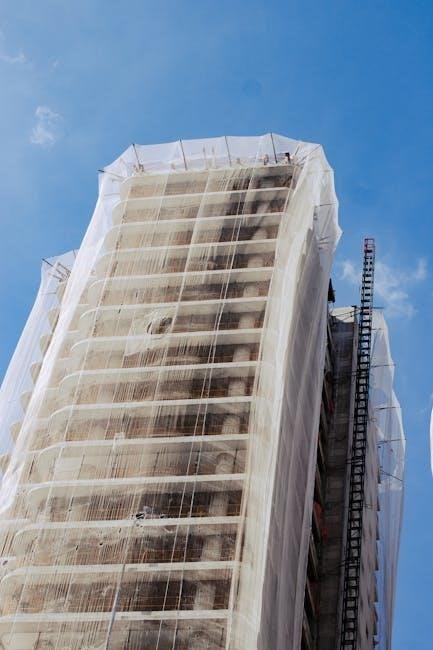A construction subcontractor agreement is a legal document outlining the scope, payment terms, and responsibilities between contractors and subcontractors. It ensures compliance with project requirements and legal standards, protecting all parties involved.
1.1 What is a Subcontractor Agreement?
A subcontractor agreement is a legally binding document between a primary contractor and a subcontractor, outlining the terms and conditions for specific tasks within a larger construction project. It defines the scope of work, payment terms, and responsibilities, ensuring clarity and accountability for all parties involved. This agreement is essential for delegating specialized work to experts, such as electricians or plumbers, while maintaining project cohesion. By formalizing the relationship, it protects both the contractor and subcontractor from disputes and ensures compliance with legal and project requirements. The agreement typically includes details like deliverables, timelines, and compensation, making it a cornerstone of successful project management in the construction industry.
1.2 Importance of a Subcontractor Agreement in Construction Projects
A subcontractor agreement is vital in construction projects as it establishes clear expectations and responsibilities between contractors and subcontractors. It ensures that all parties understand their roles, reducing the risk of conflicts and misunderstandings. By outlining payment terms, timelines, and deliverables, the agreement provides a framework for smooth project execution. It also protects both parties legally by defining liability, insurance requirements, and dispute resolution mechanisms. This document is crucial for maintaining project timelines and budgets, as it holds subcontractors accountable for their work quality and adherence to schedules. Additionally, it safeguards the primary contractor by ensuring that subcontractors comply with the terms of the prime contract. Overall, a well-drafted subcontractor agreement is essential for ensuring the successful completion of construction projects while minimizing potential disputes and financial risks.
Structure of a Construction Subcontractor Agreement
A construction subcontractor agreement outlines the scope of work, payment terms, timelines, insurance requirements, and dispute resolution processes. It ensures clarity and accountability for all parties involved in the project execution.
2.1 Parties Involved in the Agreement
A construction subcontractor agreement primarily involves two main parties: the contractor and the subcontractor. The contractor is typically hired by a client to oversee the entire project, while the subcontractor is engaged to perform specific tasks within the project scope. The subcontractor operates as an independent contractor, not an employee, and is responsible for their own taxes and insurance. Both parties must clearly outline their roles, responsibilities, and expectations to avoid disputes. Additionally, the agreement may involve other stakeholders, such as the client or project owner, who have indirect interests in the subcontractor’s work. The document ensures that all parties are legally bound to the terms, ensuring accountability and compliance with the project’s requirements. By defining the roles and obligations of each party, the agreement promotes a structured and professional working relationship, which is essential for the successful completion of the construction project.
2.2 Scope of Work and Deliverables
The scope of work and deliverables section outlines the specific tasks, responsibilities, and expectations for the subcontractor. It defines what the subcontractor is required to deliver, ensuring clarity on the project’s objectives. This section must be detailed to avoid ambiguity, specifying timelines, quality standards, and any applicable industry regulations. Deliverables are the tangible outcomes the subcontractor must provide, such as materials, labor, or completed work. The scope of work may also include adherence to the primary contractor’s project documents, like construction plans or the prime contract. By clearly defining these elements, the agreement helps prevent misunderstandings and ensures that all parties are aligned on the project’s goals. This section is crucial for maintaining accountability and ensuring that the subcontractor’s work integrates seamlessly with the broader project. Properly outlining scope and deliverables is essential for the successful execution of the construction project and maintaining a positive working relationship between all parties involved.
2.3 Payment Terms and Schedules
The payment terms and schedules section of a construction subcontractor agreement outlines the financial arrangements between the contractor and subcontractor. It specifies how, when, and under what conditions payments will be made. Common payment methods include lump-sum payments, hourly rates, or periodic installments tied to project milestones. The agreement may also detail payment schedules, such as timelines for invoices, payment due dates, and penalties for late payments. For instance, payment might be due within 30 days of invoice submission. This section often includes conditions for payment, such as the completion of specific deliverables or the achievement of predetermined project phases. It may also address payment holds or retainage, where a portion of the payment is withheld until the project is fully completed and approved. Clear payment terms ensure transparency and fairness, reducing the risk of financial disputes. Proper documentation of payment schedules is essential to maintain a smooth workflow and ensure both parties meet their obligations.
2.4 Project Timeline and Deadlines
The project timeline and deadlines section of a construction subcontractor agreement defines the start and completion dates for the subcontractor’s work. It establishes key milestones and deadlines, ensuring alignment with the overall project schedule. This section typically includes specific dates for when the subcontractor must begin work, complete tasks, and finalize deliverables; Delays or extensions are addressed, with provisions outlining the process for requesting extensions and any potential penalties for missing deadlines. The timeline may also specify how changes in the main project schedule affect the subcontractor’s obligations. Clear deadlines ensure accountability and help maintain project momentum. Proper documentation of timelines prevents misunderstandings and provides a framework for tracking progress. By setting precise expectations, this section supports efficient project execution and minimizes risks related to delays or missed deadlines. This ensures that all parties are aligned and working toward the successful completion of the project within the agreed-upon timeframe.
2.5 Insurance and Liability Clauses
Insurance and liability clauses in a construction subcontractor agreement outline the insurance requirements and liability allocation between the contractor and subcontractor. These clauses ensure that both parties are protected against potential risks and losses. The subcontractor is typically required to maintain specific types of insurance, such as general liability, workers’ compensation, and vehicle liability insurance, with minimum coverage limits specified in the agreement. The subcontractor must provide proof of insurance, such as certificates of insurance, before commencing work. Liability clauses clarify who is responsible for damages or injuries arising from the subcontractor’s work. These provisions protect the contractor and subcontractor by establishing clear boundaries of responsibility and ensuring compliance with legal and project standards; Properly drafted insurance and liability clauses help mitigate financial risks and ensure that all parties are adequately covered throughout the project duration. These clauses are critical for maintaining a secure and legally compliant working relationship.
2.6 Dispute Resolution Mechanisms
Dispute resolution mechanisms in a construction subcontractor agreement outline the processes for resolving disagreements between the contractor and subcontractor. These clauses are essential to ensure that any conflicts are addressed efficiently and fairly. Common mechanisms include binding arbitration, non-binding arbitration, or mediation. The agreement may specify the type of dispute resolution method, the venue, and the rules governing the process. For example, binding arbitration involves appointing a neutral third party to make a final decision, while mediation focuses on negotiation to reach a mutually acceptable solution. The subcontractor agreement may also include provisions for notice periods, allowing both parties to attempt resolution before escalating the issue. These mechanisms help prevent disputes from halting project progress and protect both parties from prolonged legal battles. By including clear dispute resolution terms, the agreement ensures that conflicts are managed constructively, maintaining the working relationship and project continuity. This section is crucial for minimizing risks and ensuring smooth project execution.

Key Components of the Agreement
A construction subcontractor agreement includes key components such as scope of work, payment terms, project timelines, insurance, dispute resolution, and compliance standards.

3.1 Roles and Responsibilities
In a construction subcontractor agreement, roles and responsibilities are clearly defined to ensure clarity and accountability. The subcontractor is responsible for completing specific tasks as outlined in the scope of work, adhering to project standards, and meeting deadlines. The contractor, meanwhile, oversees the subcontractor’s work, ensures compliance with the prime contract, and manages overall project coordination. Both parties must communicate effectively to address any issues promptly. The subcontractor is also responsible for maintaining necessary insurance, adhering to safety protocols, and complying with all applicable laws and regulations. Clear delineation of roles helps prevent disputes and ensures the project progresses smoothly. By outlining expectations upfront, both parties can focus on delivering quality work and meeting project objectives effectively.
3.2 Work Quality and Standards
In a construction subcontractor agreement, work quality and standards are critical to ensure the project meets the required specifications and expectations. The subcontractor is obligated to deliver work that aligns with industry standards, using approved materials and methods. The agreement typically outlines specific quality benchmarks, such as adherence to building codes, safety regulations, and the prime contract’s requirements. The subcontractor must ensure that all work is free from defects and completed in a professional manner. Regular inspections by the contractor or project owner may be required to verify compliance with these standards. Any deviations or subpar work must be corrected promptly at the subcontractor’s expense. By maintaining high-quality work, the subcontractor contributes to the overall success of the project and upholds the contractor’s reputation. Clear expectations for work quality help prevent disputes and ensure a satisfactory outcome for all parties involved.

3.3 Compliance with Laws and Regulations
A construction subcontractor agreement must explicitly state that the subcontractor is responsible for complying with all applicable federal, state, and local laws, including building codes, zoning regulations, and safety standards. The subcontractor must ensure that their work adheres to the project’s legal requirements and any permits or licenses necessary for the tasks assigned. This includes compliance with environmental regulations, labor laws, and anti-discrimination policies. Failure to meet these obligations can result in legal action, financial penalties, or termination of the agreement. The subcontractor is also obligated to maintain proper documentation, such as certifications or permits, to demonstrate compliance. By adhering to these legal standards, the subcontractor ensures that their work is lawful and aligns with the broader project goals. Compliance with laws and regulations is essential for maintaining the integrity and legitimacy of the construction project.
3.4 Safety Protocols and Measures
Safety protocols and measures are critical components of a construction subcontractor agreement to ensure a safe working environment and compliance with industry standards. The subcontractor must adhere to all applicable safety regulations, including OSHA guidelines, and implement measures to prevent accidents and injuries. The agreement should outline the subcontractor’s responsibility to provide proper safety training to their employees, ensure the use of personal protective equipment (PPE), and maintain a hazard-free workspace. Regular safety audits and inspections may be required to verify compliance. Additionally, the subcontractor must report any safety incidents or near-misses to the primary contractor promptly. The agreement may also specify that the subcontractor is liable for any safety violations or negligence that result in harm to personnel or property. By including these provisions, the agreement helps minimize risks and ensures that all parties prioritize workplace safety throughout the project duration.
3.5 Intellectual Property and Ownership
Intellectual property and ownership clauses in a construction subcontractor agreement address the rights to designs, plans, and materials created during the project. Typically, the primary contractor retains ownership of all intellectual property, while the subcontractor is granted a license to use these materials solely for project completion. The subcontractor agrees not to claim ownership or rights to the intellectual property unless explicitly stated in the agreement. Any innovations or designs developed by the subcontractor as part of the project are usually deemed the property of the primary contractor. This ensures that the contractor maintains control over the project’s creative and technical aspects. The subcontractor is also required to protect the contractor’s intellectual property from unauthorized use or disclosure. These provisions safeguard the contractor’s interests and clarify the subcontractor’s role in contributing to the project without gaining proprietary rights. This section is essential for maintaining legal clarity and protecting sensitive information.
Legal and Financial Considerations
Legal and financial considerations in subcontractor agreements include payment methods, breach consequences, and dispute resolution. They ensure compliance with laws, secure payments, and outline penalties for non-compliance, protecting both parties’ interests effectively.
4.1 Contractual Obligations and Breach Consequences
Contractual obligations outline the duties of both contractors and subcontractors, ensuring adherence to project terms. Breach consequences, such as penalties or termination, are defined to address failures in meeting agreed-upon responsibilities, safeguarding project integrity and accountability.
4.2 Payment Methods and Terms
Payment methods and terms in a construction subcontractor agreement define how and when payments will be made. Common methods include lump-sum payments, hourly rates, or milestone-based payments. Terms specify payment schedules, such as upon completion, in installments, or periodically. Payment conditions may require the contractor to pay the subcontractor after receiving payment from the client or upon satisfactory work completion. Delays in payment can lead to penalties or interest, as outlined in the agreement. Subcontractors may also be entitled to request payment schedules to ensure steady cash flow. It’s essential to clearly outline acceptable payment methods, such as checks, bank transfers, or digital payments, to avoid disputes. Changes in payment terms due to project scope modifications or delays must be documented through change orders or extensions. Ensuring transparency in payment terms helps maintain a smooth working relationship between contractors and subcontractors.
4.3 Change Orders and Variations
Change orders and variations in a construction subcontractor agreement address modifications to the original scope of work. These changes can arise from client requests, unforeseen site conditions, or design alterations. The agreement must outline the process for requesting, approving, and implementing changes. Subcontractors are typically entitled to additional compensation or time for performing extra work beyond the initial agreement. The documentation of change orders ensures transparency, with details on the nature of the change, cost impact, and timeline adjustments. Both parties must sign off on changes to avoid disputes. The agreement should specify how variations affect payment terms, such as incremental payments or adjusted milestones. Effective management of change orders is crucial to maintaining project timelines and budgets, ensuring that all parties understand their obligations and the implications of any modifications. This section safeguards both contractors and subcontractors by providing a structured approach to handling project changes.
4.4 Delays and Extensions in Project Timeline
Delays and extensions in project timelines are common challenges in construction projects. A subcontractor agreement must address how delays are managed to ensure minimal disruption. The agreement typically includes clauses outlining the process for notifying delays, such as unforeseen site conditions or force majeure events. Subcontractors are often required to inform the contractor promptly in writing, explaining the cause and estimated impact on the timeline. Extensions of time may be granted if delays are justified and beyond the subcontractor’s control. The agreement should specify how timeline adjustments affect payment schedules and deadlines. Penalties for delays caused by the subcontractor, such as failure to meet milestones, may also be included. Conversely, if delays are due to the contractor or other factors, the subcontractor may be entitled to time extensions without penalties. This section ensures both parties understand their obligations and the consequences of delays, maintaining project continuity and fairness. Clear documentation is essential to avoid disputes.

Best Practices for Creating an Effective Agreement
Draft clear, concise terms to avoid ambiguity. Ensure legal review for compliance. Collaborate with both parties to align expectations; Use standardized templates and negotiate fairly to create a balanced, legally sound agreement.
5.1 Drafting Clear and Concise Terms
Drafting clear and concise terms in a construction subcontractor agreement is essential for avoiding disputes and ensuring all parties understand their roles and responsibilities. Use simple, direct language to define project scope, payment terms, timelines, and deliverables. Avoid vague statements or legal jargon that could lead to misinterpretation. Ensure all clauses are straightforward, with specific details about work quality, payment schedules, and liability. Clearly outline expectations for compliance with laws, safety protocols, and intellectual property rights. By maintaining clarity, both contractors and subcontractors can focus on project execution without confusion. Regular legal reviews can further refine the document, ensuring it meets all necessary standards and protects both parties’ interests effectively. A well-drafted agreement fosters collaboration and trust, which are critical for the success of any construction project.
5.2 Negotiation Tips for Both Parties
Effective negotiation is crucial when creating a construction subcontractor agreement. Both parties should approach discussions with transparency and mutual respect. Contractors should clearly outline their expectations and project requirements, while subcontractors should ensure their capabilities and limitations are understood. Active listening and open communication can help prevent misunderstandings. It’s important to balance flexibility and firmness, focusing on win-win solutions. Subcontractors should negotiate fair payment terms, timelines, and scope of work to avoid overcommitting. Contractors, on the other hand, should ensure the agreement aligns with the prime contract and project goals. Both sides should prioritize clarity on liability, insurance, and dispute resolution to minimize risks. Negotiation is not about one party winning but about creating a partnership that supports project success. By addressing concerns early and maintaining a collaborative mindset, both parties can achieve a balanced and equitable agreement.

5.3 Legal Review and Consultation
Engaging legal experts for a thorough review of the subcontractor agreement is essential to ensure compliance with relevant laws and regulations. A legal consultation helps identify potential risks and ambiguities in the contract, safeguarding both parties’ interests. Attorneys can verify that the agreement aligns with local, state, and federal requirements, ensuring the subcontractor is treated as an independent contractor. They also review clauses related to payment terms, liability, and dispute resolution to avoid future conflicts. Legal experts can suggest modifications to clarify ambiguous terms and strengthen the agreement. Additionally, they ensure the subcontractor’s obligations align with the prime contract, preventing discrepancies. Consulting with legal professionals provides peace of mind and helps both parties understand their rights and responsibilities. Regular legal reviews are especially crucial for complex projects or those involving significant financial stakes. By investing in legal consultation, contractors and subcontractors can avoid costly disputes and ensure a smooth project execution.
